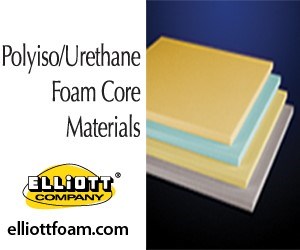NIAR innovates overmolded TPC production process for eVTOLs
Fully automated hybrid thermoforming and injection overmolding process was executed to produce complex thermoplastic composite rib structure in 2 minutes versus 100-hour metal counterpart.
The National Institute for Aviation Research (NIAR) at Wichita State University (WSU, Kan., U.S.) has announced the engineering of a thermoplastic composite (TPC) rib structure, showcasing the potential of fully automated hybrid thermoforming and injection overmolding.
The program, led NIAR’s Advanced Technologies Lab for Aerospace Systems (ATLAS), was able to cut production time from 100 hours to 2 minutes, marking improvements in aerospace manufacturing efficiency. By integrating two key polymer processing techniques, NIAR says the process enables the production of high-performance, lightweight components with greater design flexibility and cost efficiency.
The development was part of the Air Force Research Laboratory’s (AFRL) Manufacturing for Affordable Sustainable Composites program and was made possible through collaboration with industry, including Joby Aviation, Toyota, KraussMaffei, Victrex and Prospect Mold.
“This was a particularly challenging component, traditionally machined from a metal billet — a process that removes over 80% of the material and takes more than 100 hours to complete,” says Dr. Waruna Seneviratne, director of NIAR ATLAS. “In contrast, the thermoplastic [composite] part was formed from a flat thermoplastic organosheet in under 2 minutes. The expertise of each partner was instrumental in achieving this success.”
In 2024, NIAR researchers collaborated with KraussMaffei to develop a thermoplastic overmolded window cover for passenger-to-cargo conversions that can be produced in just 90 seconds. The resulting component ended up being 20-30% lighter and cost half as much as its metal counterpart.
“These advancements underscore the potential of automotive-matured overmolding technology for high-rate production of primary and secondary aircraft structures,” adds Seneviratne.
The project has also expanded its collaboration to include Fill Engineering, aiming to develop a fully integrated manufacturing cell for rib structure production. This system will incorporate material preparation, tape laying, ultrasonic tack welding, consolidation, organosheet trimming and overmolding. The production cell is scheduled for commissioning at NIAR in fall 2025.
In addition, researchers have broadened their study to include thermal, physical and mechanical testing to validate process repeatability and ensure part quality. NIAR says these efforts will provide crucial certification guidance for overmolded aircraft structures.
“NIAR’s work aligns with the aerospace industry’s ongoing shift toward sustainable, high-performance materials and advanced manufacturing techniques that improve efficiency while reducing costs,” says Seneviratne. “As high-rate production methods continue to gain traction, innovations like these could play a pivotal role in the future of aerospace manufacturing.”
Related Content
-
Welding is not bonding
Discussion of the issues in our understanding of thermoplastic composite welded structures and certification of the latest materials and welding technologies for future airframes.
-
JEC World 2024 highlights: Thermoplastic composites, CMC and novel processes
CW senior technical editor Ginger Gardiner discusses some of the developments and demonstrators shown at the industry’s largest composites exhibition and conference.
-
Development of a composite liquid hydrogen tank for commercial aircraft
Netherlands consortium advances cryogenic composites testing, tank designs and manufacturing including AFP, hybrid winding, welding of tank components and integrated SHM and H2 sensors for demonstrators in 2025.

















